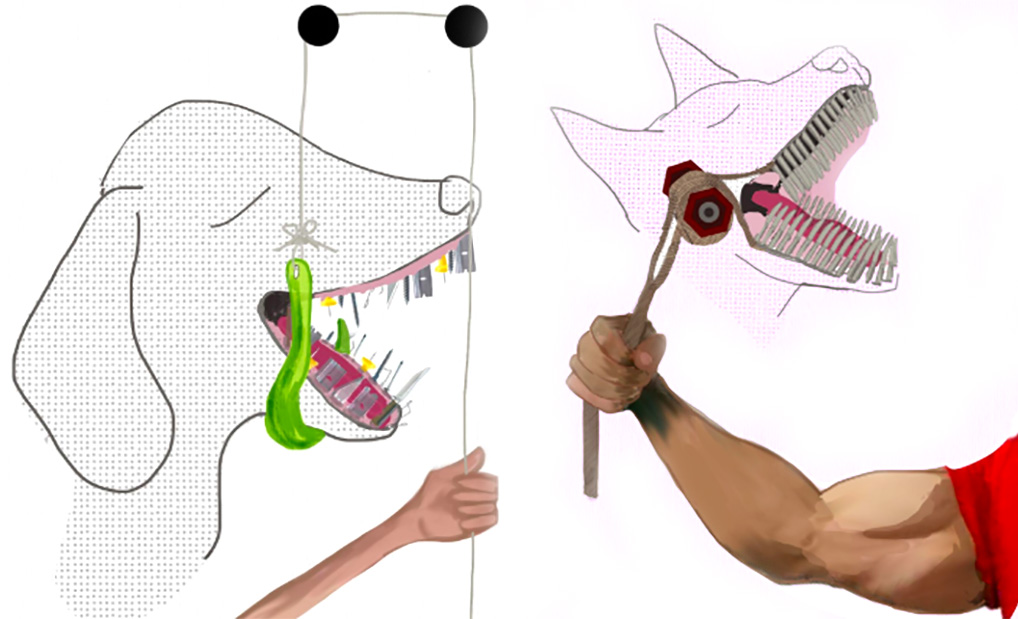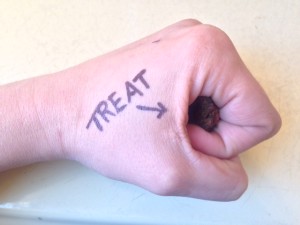
22 May7 ways to deal with puppy bites
Listen to our podcast episode on nipping here!
Playing with a puppy often means having your hands nipped. And your shirt, your socks, your hair… This is normal, as puppies explore the world with their mouths in much the same way as children use their hands. Nipping may get worse at around 16-weeks-old, when puppies begin to lose their baby teeth, which is all the more reason to start dealing with biting as soon as you bring your puppy home.
Here are some ways to work towards teaching your dog to understand how to properly use his mouth when interacting with you.
1. LET YOUR PUPPY LEARN FROM OTHER PUPPIES
Puppies usually learn bite inhibition during play with other puppies. If you watch a group of puppies playing, you’ll see that they constantly bite each other all over. Every now and then, a pup may bite a playmate too hard and the victim yelps and usually stops playing. The offender is often taken aback by the yelp and also stops playing for a moment. He's processing the feedback. Through this kind of interaction, puppies learn to control the intensity of their bites so that no one gets hurt and the play can continue without interruption. In fact, some theorize that puppy teeth evolved to be so sharp so that they’d learn to use their mouths delicately during play before they get their stronger-but-duller adult teeth.
The more appropriate puppy play your dog gets, the less he will be trying to treat your hands and feet like play things. If he expends a lot of his energy playing with other puppies, he’ll feel less motivated to play roughly with you. (If you're looking for play groups, we hold them three days a week
2. TURN BITING INTO AN OFF SWITCH
Biting is usually a self-reinforcing activity; the more your dog bites, the better he gets at biting, and the more he learns to enjoy it. Often, we inadvertently reinforce puppy biting by responding with noises and attention that are likely to be rewarding to your dog. This is why time-outs can be very effective for curbing mouthing in puppies. When your puppy delivers a hard bite, try to become extremely boring and still for ten seconds; put your head down, tuck your hands in your armpits, and be quiet. You can “awaken” again when your puppy takes a break or initiates a more appropriate type of play.
3. GIVE GOOD CHEW TOYS
Make sure your dog has plenty of great things to chew on, especially as he begins losing his teeth. Bully sticks are great for big chewers. We have a bunch of bully stick holders which can help extend their life and can make chewing all the more fun. You might also experiment with frozen carrots, ice cubes, and pig’s ears. Monitor chewing whenever possible, especially if your dog is chewing anything where a piece can possibly break off and get lodged in the digestive tract.
4. PLAY GAMES WHERE THEY USE THEIR MOUTHS APPROPRIATELY
Encourage non-contact forms of play, such as fetch and tug-of-war, rather than wrestling and rough play with human hands. Once your puppy can play tug safely, keep tug toys easily accessible. If he starts to mouth you, you can immediately redirect him to the tug toy. Ideally, he’ll start to anticipate and look for a toy when he feels like mouthing. It's great to use long toys, so that your dog doesn't make the mistake of grabbing your hand instead of the toy! We like to use extra long rope tugs at School For The Dogs, or else Flirt Poles.
5. KEEP YOUR HANDS AWAY FROM YOUR PUPPY'S FACE
Puppies often mouth on people’s hands when stroked, patted and scratched. They’re even more likely to do this if you have your hands near their mouths! I often have clients say “he keeps biting me!” and then I look down and see the owner is playing with the puppy's face. If you have your hands all over your puppy's face and you're doing exciting things with them, guess what your puppy is going to do! If your puppy is riled up while you are playing with him or petting him, you can feed small treats out of one hand while petting with another. If it's too hard to give individual treats, you an use something like Liquid Treat Dispenser, or make you hands into what we call “Hand Kong,” a fist tightly holding treats that your dog can just barely get to. This will help your puppy get used to being touched without mouthing.
6. MAKE YOUR HANDS MORE LICKABLE THAN BITABLE
In situations when you know your dog might be particularly mouthy– perhaps when you pick him up, or when he comes in from a walk — put a small amount of butter or peanut butter on your hand. This will encourage your dog to lick your hand in these situations, rather than nibbling on it. Licking and biting are incompatible behaviors, so encouraging the former will mean that biting won’t be happening.
7. ENCOURAGE OTHER FUN MOUTH ACTIVITIES
Feed meals in work-to-eat toys. By challenging your dog at mealtimes, you’ll be helping to tire him out while doing something appropriate that exerts the use of the mouth. A mouth that is working on a food toy is a mouth that isn’t bored and trying to bite through your sock.




